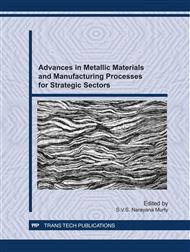p.463
p.471
p.477
p.483
p.489
p.495
p.500
p.506
p.511
Comparative Study on Tempering Response of Martensitic Grade AISI-420 Stainless Steels with Varying Carbon Content
Abstract:
Martensitic grade stainless steels are being extensively used in aerospace, defence and nuclear sectors for structural applications. Specialized applications require close control in chemistry and heat treatment parameters. Control of carbon in AISI-420, alloying content has typical service advantages. To study the effect of tempering temperature with carbon content on mechanical properties, various heat treatment cycles were devised, avoiding the regime of temper embrittlement. This paper presents the tempering response of medium carbon stainless steel AISI-420 grade with respect to change in carbon content from 0.2% to 0.3%. It is observed that, by varying the tempering temperature, the grade can be tailored to obtain wide range of mechanical properties. With increasing carbon content, martensite is found to be changing in morphology from lath to lath & plate (mixed) and the amount of retained austenite also increases. An attempt has been also made to arrive at a structure-property correlation in this grade of stainless steel.
Info:
Periodical:
Pages:
489-494
Citation:
Online since:
January 2012
Keywords:
Price:
Сopyright:
© 2012 Trans Tech Publications Ltd. All Rights Reserved
Share:
Citation:


